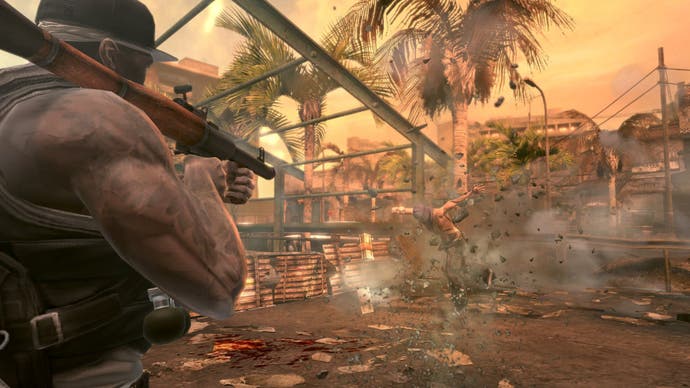50 Cent: Blood on the Sand
Off the hook, the map, the meat rack and radar.
"The first thing we had to do was deliver a game that was much, much, much better than the original," says Julian Widdows, game director on 50 Cent: Blood in the Sand. "While it was a huge commercial success, I don't think anyone is particularly shy of that fact that it wasn't critically well-received. It wasn't the game people wanted."
Well, that addresses the first elephant in the room, at least. At a recent demo of a couple of levels of the latest product pimping Curtis Jackson's screwface, developer Swordfish Studios got straight to the point. We welcome an honest answer, and it saves us the trouble of describing Bulletproof's gameplay as being akin to getting kicked in the cock by Satan's cloven hoof. If we can't be blunt when talking about a 50 Cent game, when can we?
According to Swordfish, 50 Cent: Blood on the Sand is built on six pillars: gunplay, interactive counter-kills, your G-Unit buddy system, online play, music and the levels featuring driving and flying. The last three are being kept under wraps to some degree, but considering the amount of exclusive content that came with the first game, anything less than multiple music tracks, remixes, videos and a new soundtrack is going to feel like the fan has been stiffed. We're also a little dubious of the driving and flying levels, especially when you consider they only make up three of the 24 levels in the game. We can't judge because we haven't seen them, but memories of token car chases stuffed into games to tick a check-box give us the shudders.
So, onto what we have seen, and what we can judge so far. Like the first, Blood on the Sand is about excessive gunplay in linear environments. The hub section from Bulletproof has been thrown out, which is no great loss, as Swordfish pumps up the arcade experience further. It looks and plays similar to other Unreal Engine third-person shooters, with an over-the-shoulder view, a cover mechanic and blindfire. But Swordfish wants to reward the player who's not afraid of a little lead poisoning, and who's brave enough to go barrels-first at the enemy.

"The key difference between this and something like Gears of War is that we actively encourage open ground play. We don't force the player into cover and keep them there. We allow them to get out of cover and dive into combat and get engaged in the balls-out action," offers Widdows.
Points are awarded for headshots, blowing people up with explosives, open ground risks, and with secondary objectives the game hurls points at the player, "almost like pinball, where you get the bigger awards for the combos," says Widdows. Cash and jewelry left by corpses can be spent on weapons and counter-kills, and the game also throws scenarios at the player - shoot a set number of enemies, gather enough loot, leg it through a level in a set timeframe - to acquire grenades, mines, Molotov cocktails, and other explosives that can only be snaffled through this risk/reward mechanic. Build up enough points and you also get to switch to 'Gangster Fire' mode (stop cringing) where the world slows down but 50 continues at his usual 100-miles-an-hour running pace, acting like a smartbomb on the enemies.

Which brings us to the second elephant in the room - the gameplay is very reminiscent of The Club. And although screenshots aren't showing it yet, the presentation, HUD, logos, and character design also bring to mind Bizarre Creations' manic shooter.
It's an observation that isn't lost on the developer. "We were actually doing this before The Club was shipped," details Widdows. "The Club was track-based and everything was done to a time limit, whereas this is a linear, narrative, set-piece-driven shooter, with a point-scoring combo system. The original inspiration was to do for shooters what Diablo did for RPGs," he says. Time will tell how the finished game turns out, and to be fair, if you're going to borrow ideas it's always wise to borrow from the best.


